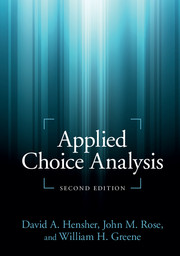Book contents
- Frontmatter
- Contents
- List of Figures
- List of Tables
- Preface
- Part I Getting started
- 1 In the beginning
- 2 Choosing
- 3 Choice and utility
- 4 Families of discrete choice models
- 5 Estimating discrete choice models
- 6 Experimental design and choice experiments
- 7 Statistical inference
- 8 Other matters that analysts often inquire about
- Part II Software and data
- Part III The suite of choice models
- Part IV Advanced topics
- Select glossary
- References
- Index
2 - Choosing
from Part I - Getting started
Published online by Cambridge University Press: 05 June 2015
- Frontmatter
- Contents
- List of Figures
- List of Tables
- Preface
- Part I Getting started
- 1 In the beginning
- 2 Choosing
- 3 Choice and utility
- 4 Families of discrete choice models
- 5 Estimating discrete choice models
- 6 Experimental design and choice experiments
- 7 Statistical inference
- 8 Other matters that analysts often inquire about
- Part II Software and data
- Part III The suite of choice models
- Part IV Advanced topics
- Select glossary
- References
- Index
Summary
As soon as questions of will or decision or reason or choice of action arise, human science is at a loss.
(Noam Chomsky, 1928 –)Introduction
Individuals are born traders. They consciously or subconsciously make decisions by comparing alternatives and selecting an action that we call a choice outcome. As simple as the observed outcome may be to the decision maker (i.e., the chooser), the analyst who is trying to explain this choice outcome through some captured data will never have available all the information required to be able to explain the choice outcome fully. This challenge becomes even more demanding as we study the population of individuals, since differences between individuals abound.
If the world of individuals could be represented by one person, then life for the analyst would be greatly simplified, because whatever choice response we elicit from that one person could be expanded to the population as a whole to get the overall number of individuals choosing a specific alternative. Unfortunately there is a huge amount of variability in the reasoning underlying decisions made by a population of individuals. This variability, often referred to as heterogeneity, is in the main not observed by the analyst. The challenge is to find ways of observing and hence measuring this variability, maximizing the amount of measured variability (or observed heterogeneity) and minimizing the amount of unmeasured variability (or unobserved heterogeneity). The main task of the choice analyst is to capture such information through data collection, and to recognize that any information not captured in the data (be it known but not measured, or simply unknown) is still relevant to an individual’s choice, and must somehow be included in the effort to explain choice behavior.
- Type
- Chapter
- Information
- Applied Choice Analysis , pp. 16 - 29Publisher: Cambridge University PressPrint publication year: 2015



